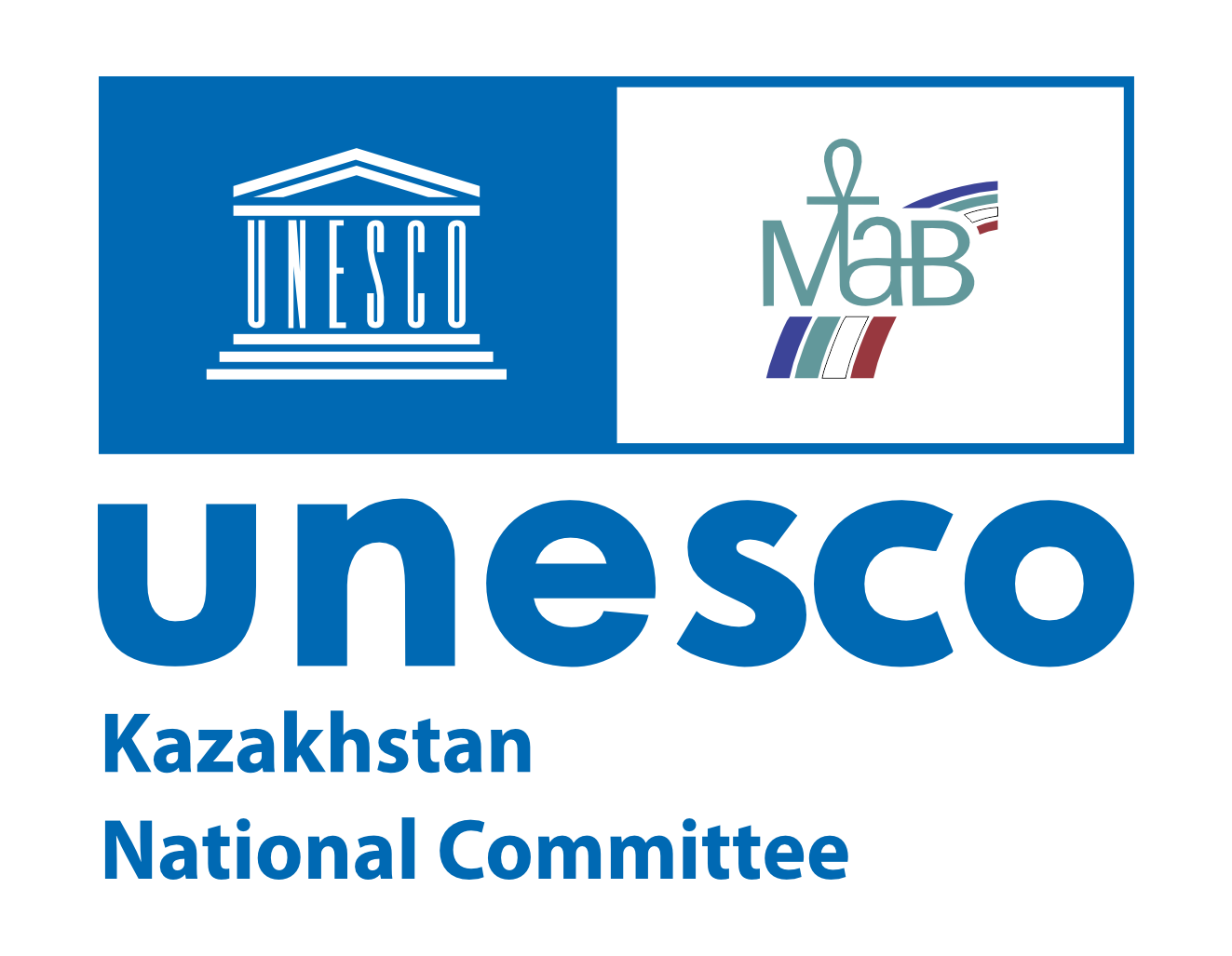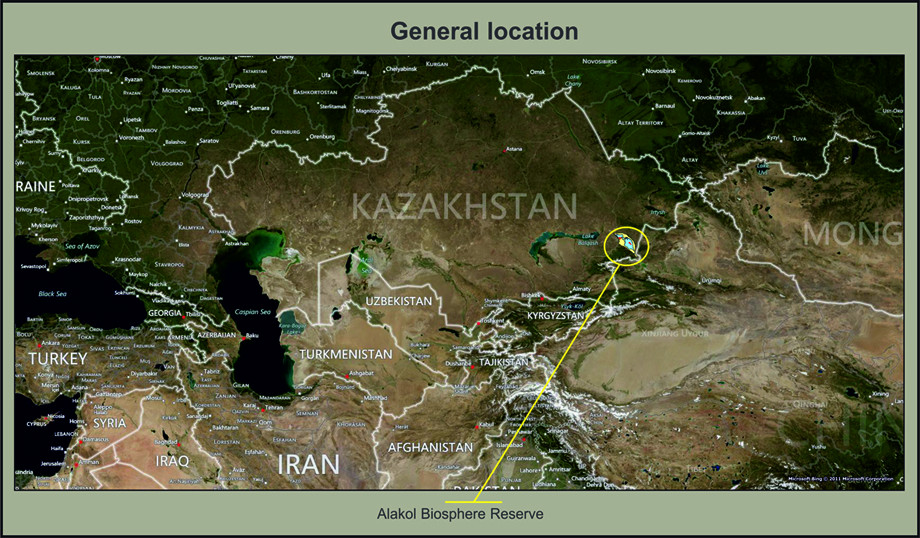
Total area of Alakol Biosphere Reserve's territory is 193 089.9 ha (with water areas – 529 300 ha). The core zone (which is strict reserve zone of Alakol State Nature Reserve) is 19 712,9 ha, buffer zone – 26 667 ha (2 km stripe along nature reserve's perimeter), transition zone – about 511 300 ha.
The core zone of Biosphere Reserve is strictly protected nature reserve zone of Alakol State Nature Reserve, which represents wetland natural complex of Tentek river delta, also including a part of Sasykkol lake waters and three islands of Alakol lake with their coastal territories, which are very important nesting areas for many rare bird species. According to article 39 chapter 7 of the Law of RK «About specially protected natural territories», state nature reserve is a specially protected natural territory with the status of nature-protective and scientific institution, the main goal of which is conservation and research of the natural processes, objects of plant and animal world, separate species and associations of plants and animals, typical and unique ecological systems and their rehabilitation. It is permitted to create excursion paths and routes for regulated ecological tourism at specially provided areas which don't include especially valuable ecological systems and objects, in the order stipulated by the authorized body (article 42). Alakol State Nature Reserve corresponds with the highest category (1A) of natural territories of International Union for Conservation of Nature.
The area of the core zone of Alakol Biosphere Reserve is 19 712.9 ha. Core zone is compiled of four areas – Tentek river delta, Ulken Araltobe island, Sredniy and Kishkene Araltobe islands. The border of the main Reserve's territory in Tentek river delta begins from the coastal line of Sasykkol lake, Burgon bay, goes through marshy area in South-Eastern direction for 7 km to Togyztubek tract along the border of Kabykbayev's farm. Then it turns strictly to the West to Miyaly tract. Then the border continues in Southern direction until Kaskyrzhota tract for 12 km. From Kaskyrzhota tract to Kokpekty tract the border also goes through wetlands along Alakol forestry farm border in South-Western direction to the bridge over a channel to Shiryayev island for 19 km, turns North along delta water reservoirs: Kugumbay, Intymak, Safron and until Alyokhin's farm. Then it changes direction to the West until Baibala tract, around channel in South-Eastern direction is comes back to the bridge to Shiryayev island with total length of 20.2 km. The distance between the borders is 1.5 km, and then the border goes to South-West along the borders of Baizhumanova's farm, Tolgambay's farm, Filimonov's farm to Karamoyin tract along the border of Shumenov's farm to Zharsuat tract for 15.4 km. The border of nature reserve goes through the waters of Sasykkol lake to Zharsuat tract on the South-Western side of Sasykkol lake to Burgon bay with length of 40 km.
Total area of the core zone on Tentek river delta part is 17 422.9 ha. The area of the islands: Ulken Araltobe - 2 119 ha, Kishkene Araltobe – 148 ha and Shednyi – 23 ha. The territory of cre zone of Tentek river delta parts and two islands – Ulken Araltobe and Kishkene Araltobe – are located in Alakol district of Almaty oblast on the total area os 19 564.9 ha, and Srednyi island – in Urzhar district of Eastern-Kazakhstan oblast (23 ha).
According to the legislation of Kazakhstan, the buffer zone of Alakol Biosphere Reserve is a protective zone of nature reserve which embraces twi-kilometer stripe along the nature reserve's core zone perimeter. According to Article 43 of the Law of RK «About SPNA», protective zones are created for protection from unfavourable external impacts around specially protected natural territories with prohibition of any activity that would negatively influence the condition and rehabilitation of the given territory's ecosystems. On the territory of Biosphere Reserve the lands of the buffer zone are not withdrawn from the main land users, they consist of the lands of agricultural purpose and are administered by agricultural organizations and private owners. Economic activity at some parts of the protective zone (haymaking, cattle pasture) is carried out by agreement with state authorized body (Forestry and Hunting Committee under the Ministry of Agriculture of the Republic of Kazakhstan) and under the control of state nature reserve's administration. The territory of Biosphere Reserve's buffer zone is the place for conduction of activities in ecological education, recreation, ecotourism, as well as for scientific research. The area of the buffer protective zone is 26 667 ha. In Tentek delta the buffer zone is 21 547 ha (including 4 400 ha of Sasykkol lake waters), and around Ulken Araltobe, Srednyi and Kishkene Araltobe islands – 5 130 ha.
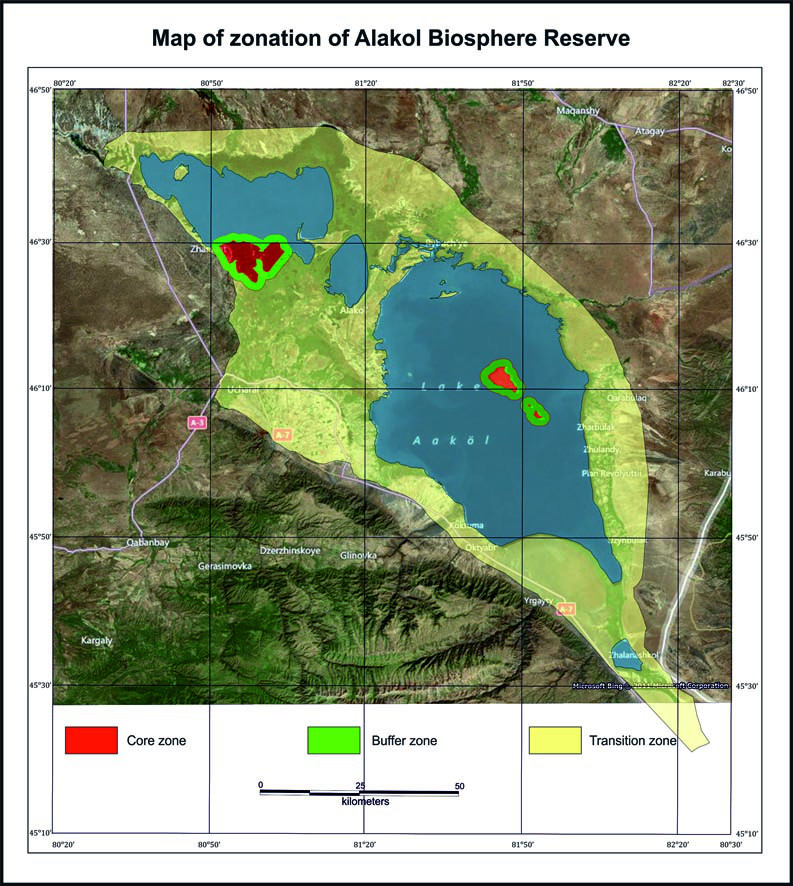
The transition zone (zone of development, collaboration) of Alakol Biosphere Reserve is located on the territory of two administrative districts of two oblasts: mainly in Alakol (Almaty oblast) and partly in Urzhar district (Eastern-Kazakhstan oblast). Total area of transition zone's terrestrial territory is 146 710 ha (with water areas – 511 300 ha).
The biggest land users of Alakol and Urzhar districts are agricultural complanies with 251 885 ha of the territory (18 416 ha are arable). Other large land users include organizations working with industry, transport, communications and defense. These organizations, the largest of which are Atasu-Alashankou oil pipeline, Ministry of Defense of RK and Border Service of the Committee for National Security of RK, use the lands of non-agricultural purpose with total area of 49 882 ha. Areas occupied by settlements and their lands for the use of local people (pastures, cattle routes) – 59 363 ha. Besides, large territories belong to the State Office of Forests and Animal World Protection of Alakol district.
The territory of transition zone is occupied by pastures, numerous wetlands and villages. It is situated mainly in the regions where people live and use the land for a long time. It is important to organize rehabilitation procedures for natural resources at these territories. First of all, it concerns sustainable fishing and hunting activities.
For organization of partner relations a special Coordinational Council of Alakol Biosphere Reserve was created; its participants include representatives of state nature reserve, nature users, local authorities and public organizations.
According to the legislation of RK, economic activities management in some areas of the Reserve's buffer zone (haymaking, cattle pasture) is carried out by agreement with state authority (Forestry and Hunting Committee under the Ministry of Agriculture of RK) and under the control of state nature reserve's administration, all disputes are solved at the meetings of Coordinational Council of Biosphere Reserve. During the preparation of Resolution of Akims of Eastern-Kazakhstan oblast and Akim of Alakol district of Almaty oblast about 2-km protective zone establishment along the border of state nature reserve all matters of cooperative activities on the buffer zone lands were discussed with all nature users. Lands of the buffer zone in private possession were not withdrawn from the owners.
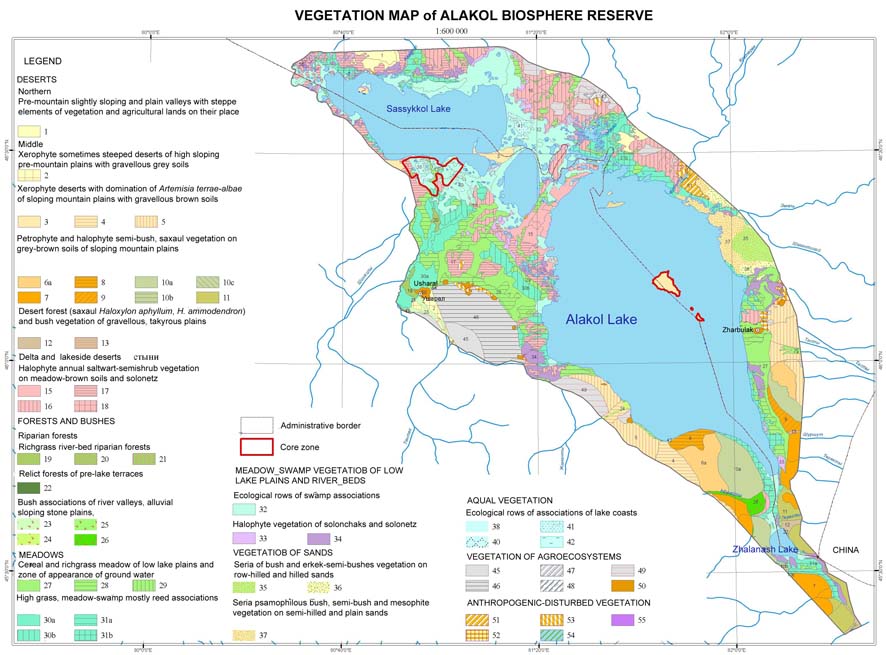
At the present time there is the Management Plan for Alakol State Nature Reserve, which relates to the management of the core and buffer zones of Biosphere Reserve. Nature users have their own management plans which are in accordance with Nature Reserve's Management Plan. Thus, simple uniting of all these plans would result in an Integrated Management Plan of the whole Biosphere Reserve's territory. There is no special management plan for Biosphere Reserve which would include the transition zone, because there is no need in it at the modern stage of Reserve's development. All disputes are solved at the meetings of Coordinational Council of Biosphere Reserve.
Biosphere Reserve's managment is conducted through Coordinational Council of Alakol Biosphere Reserve created in 2012. Before that the territory was managed through Scientific-technical Council of nature reserve (until July 2012). Coordinational Council is a collegiate public organ and is created for introduction of the policy of effective management and resources' sustainable use, introduction of alternative activity types, resource-conserving and resource-renewing technologies. Biosphere Reserve's Coordinational Council, with its members consisting of state agencies representatives (territorial office of forestry and hunting and territorial office of fishery), state nature reserve, Akimats, local NGO and land users, is also necessary for establishing collaboration and decreasing contradicitons between all nature users.
On the territory of Biosphere Reserve there is an ongoing monitoring of condition and conservation of natural complexes, as well as rare and endangered species monitoring in order to clarify populations' condition, research peculiarities of plant and animal rare species' ecology; this would give an opportunity to evaluate the perspectives of these species' conservation and rehabilitation. The goal of the monitoring is to obtain regular objective data on the condition of plants and animals on the territory of Biosphere Reserve, as well as their habitat condition. Based on the monitoring data, it is necessary to carry out routine evaluation of populations' and ecosystems' condition, biosphere reserve's effectiveness, as well as elaboration of methods for prevention (elimination) of critical and unfavourable situations. In the frame of monitoring «Nature Chronicles» are recorded, as well as population countings of large waterbirds (swans, flamingo, pelicans, etc.), mammals and invertebrate animals.
According to the perspective thematic plan of scientific research, the work on the territory of SPNA in 2011-2015 is carried out for 7 scientific themes: 1) Observations of natural phenomena and processes on the territory of the Reserve and their study for the «Nature Chronicles» program, 2) Alakol Nature Reserve's flora and vegetation inventorizaiton, 3) Rare and endangered birds of Alakol Nature Reserve, 4) Cadastre of background and rare mammals of Alakol Nature Reserve, 5) Characteristics of modern condition of ichthyofauna of Alakol Nature Reserve and creation of the system for its long-term monitoring, 6) Biodiversity evaluation of the main invertebrate groups of Alakol Nature Reserve, 7) Monitoring of hydrobionts of delta water reservoirs of Alakol Nature Reserve.
The department of ecological education (consisting of 4 people) of nature reserve is responsible for organization and conduction of cultural-educational activities. Cultural-educational work is also done by the staff the department of science, information and monitoring. The goal of this department's work is forming ecological literacy, understanding of the key role of the protected territory, importance of unique nature's conservation, public support gaining, as well as raising patriotism and responsibility for the environment and, as the result, decrease of anthropogenic press on region's biodiversity. The main activities include work with mass media, publishing, museums, ecological excursions and educational tourism, interactions with teachers and educational bodies. Besides, staff of this department develops posters, leaflets and other agitational means, and also take part in organization of practice for students of nature protective courses on the basis of nature reserve.
With the support from UNDP/GEF Wetlands Project staff of state nature reserve had a chance to raise their qualifications and prepare new staff members in trips for experience exchange to Korgalzhin Biosphere Reserve, Aksu-Dzhabagly Nature Reserve, Karatau Nature Reserve (Kazakhstan), Berezin Nature Reserve (Belorussia), Zapovednik Ecological Center (Moscow, Russia), Po River Delta Pak (Italy), as well as to scientific-practical conferences in Kazakhstan (Almaty, Astana) and abroad (Minsk, Belorussia; Ravenna, Italy). In 2009-2011 different educational seminars were held for Reserve's staff concerning a variety of topics: management plant development, biodiversity monitoring, inspectors' training in report compilation procedure, compliance with the safety rules and fire-fighting techniques
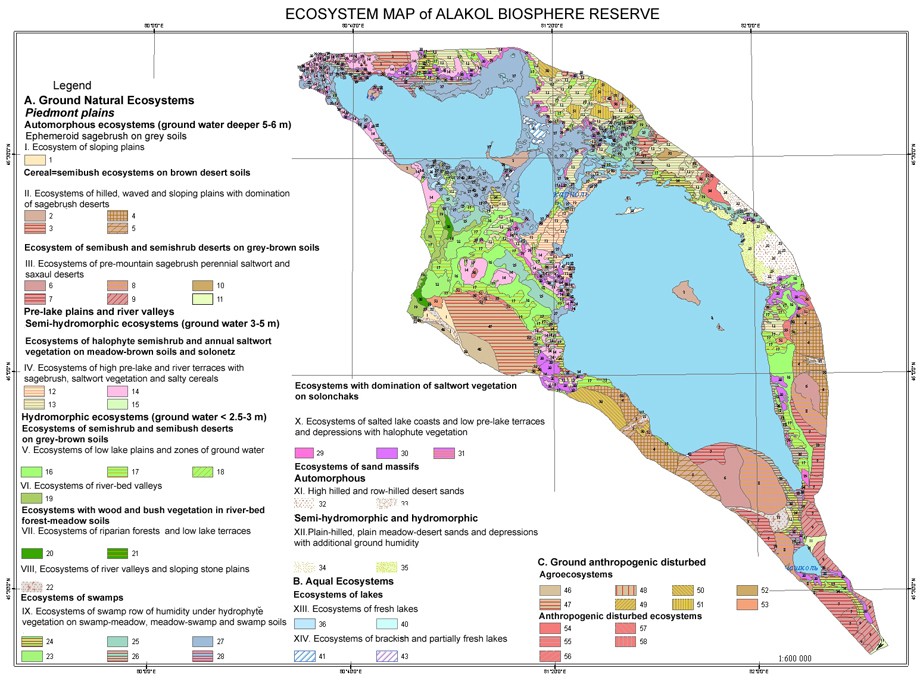
Biosphere Reserve includes Alakol-Sasykkol lake system and is situated in the limits of Alakol depression, limited by Tarbagatai ridge in the North, Dzhungarian Alatau in the South, Barlyk ridge in the East and South-East. There is a narrow pass between Barlyk ridge and Dzhungarian Alatau mountains called Dzhungarian Gates. The territory of biosphere reserve is located on the Central Asian – Indian bird migration route and is a wetland of world significance as waterbirds' habitat and aggregation site. This territory, listed in Ramsar Convention's Internationally Important Wetlands List on November 25, 2009, is nesting habitat for 203 bird species out of 342 registered here. More that half of nesting species (110) are waterbirds, 22 species of which are rare and endangered and listed in the Red Data Books of Kazakhstan and IUCN: Dalmatian Pelican Pelicanus crispus, Eurasian Spoonbill Platalea leucorodia, Flamingo Phoenicopterus roseus, Ferruginous Duck Aythya nyroca, etc.). There are 269 bird species recorded for the main and buffer zones, 110 of them are waterbirds which prevail in numbers in the season of spring and especialy autumn migrations.
Fish fauna of biosphere reserve's water reservoirs, including all important reservoirs of Alakol depression, consists of 22 species of 6 families. Native ichthyofauna is represented by 9 species, others were added artificially in 20th century; many of them are now most numerous in Alakol lakes and rivers flowing into them. One of the native species – Balkhash Perch Perca schrenki – is listed in the Red Data Book of Kazakhstan and IUCN. Core and buffer zones of biosphere reserve are inhabited by 17 species.
Amphibians are represented by 2 species, and reptiles – by 24 species, 1 species of which – Variegated Toadhead Agama Phrynocephalus versicolor – is listed in the Red Data Book of Kazakhstan.
There are 44 mammal species in biosphere reserve which belong to 6 orders: Insectivores – 4 species, Cheiroptera – 3, Predators – 10, Artiodactyls – 3, Rodents – 23 and Lagomorphs – 1 species. All mammals are subdivided in 2 groups: residents – 21 species and migrating (or locally migrating) – 23 species. Resident mammals include, first of all, rodents and insectivores, and representatives of cheiropterans, lagomorphs, predators and ungulates carry out seasonal migrations of different distance. In quantitative relation the majority of mammals are considered common or numerous species (predators, rodents). According to habitat type the mammals inhabiting this territory are divided into 2 groups: semi-aquatic and terrestrial. The first group includes only Muskrat, the second – all other mammals. Of all the teriofauna of biosphere reserve one species – Zhitkov's Jerboa Pygerethmus zhitkovi – is endemic of Kazakhstan, and 15 species are resource species, including 10 important hunting species (wolf, fox, badger, wild boar, muskrat, stoat, steppe polecat, African wildcat, Siberian roe deer, Tolai hare). There are 4 species listed in the Red Data Book of Kazakhstan: Marbled Polecat Vormela peregusna, Selevinia Selevinia betpakdalensis, Goitered Gazelle Gazella subgutturoza and Pallas’s Cat Felis manul.
Insect fauna is represented by 88 families of 13 orders, 14 species are listed in the Red Data Book of Kazakhstan and 1 species - Bolivaria brachyptera – is in IUCN Redlist.
Zooplakton composition of the lakes of Alakol-Sasykkol system consists of 140 taxons, and taxonomic composition of macro-zoobenthos is represented by 82 species and forms. Benthofauna of Alakol lake is the richest in species and forms – it contains 43 taxons.
The nominated territory of biosphere reserve contains 678 species of higher plants from 293 genera, 85 families and includes 6 endemic species and 10 subendemic species. Aquatic flora is represented by 25 plant species. There are two plant species listed in the Red Data Book of Kazakhstan: Tulipa kolpakowskiana and Tulipa brachystemon. About 40% of all floristic diversity is represented by economically important species. The main plant associations are represented by 5 main types: desert, meadow, marsh, tugai, under-water and fragmentally by 2 more types: shrub and large-leaved – forest.
Alakol Biosphere Reserve is situated on some part of the territory of Alakol district of Almaty oblast and Urzhar district of Eastern Kazakhstan oblast. Total there are 76,800 people in Alakol district, 58,800 of them are Kazakh, 16,000 are Russian, 100 Uigur, 200 German, 200 Tatar, 200 Ukranian and 1,300 of other ethnic groups. Population density of Alakol district is 3 people in 1 square kilometer. Population of Urzhar district sums up to 90,700 people, dominating ethnicities are Kazakh (87.4%) and Russian (10%), other ethnicities (2.6%) are distributed equally. Average population density is 3.9 people in 1 square kilometer. The population living in the transition zone of BR Alalkol is more than 32 thousand people. Region's economy is mainly based on agriculture.
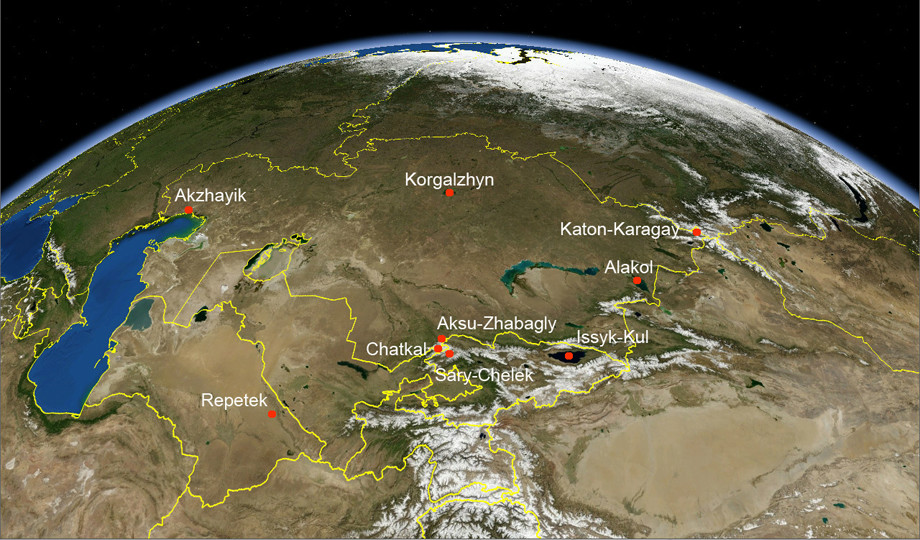
Agriculture is represented mostly by plant growing (cereals, oilseeds) and cattle breeding and to less extent by processing of agricultural production. Both districts are large agro-industrial complexes. Urzhar district is famous for its large meat factory for a long time; even nowadays it provides meat and sausage production for the whole region. In both districts there are different companies for cattle breeding and growing of sunflower, cereals and melons, some companies produce sunflower oil and flour.
Industry of Alakol district is represented by such large companies as «Asia Sakhar» sugar factory, «Rybprom» fish factory, «Kazmunaigaz» tank farm, «Kaztransservis» tank farm, «TSC-agro» corporation, «Agropromtekhnika» joint-stock company which collaborates with «Vita-Soya» company involved in growing, investment and purchase of soybean from other agricultural production companies of the region, and other companies of republican and local level. «Asia Sakhar» sugar factory provides work for up to 600 people, and besides local raw materials the factory processes sugar cane imported from the countries of Southern America and Australia; up to 15,000 tons of raw material are processed here every year. «Rybprom Ltd.» fish factory and another one near Beskol railroad station specialize in production of fish fillet for export to European countries. Each factory can process 5 tons of fish a day, but this volume is now unachievable because of fish resources lack in the nearest lakes. The remains of the fish raw material are used for fish-bone meal production, which is exported to China and other countries.
“Atasu-Alashankou” oil pipeline construction also positively influences the economy of Alakol district: there are new jobs, increasing demand for food, accommodation, fuel, repair parts and expendables for cars and railroad services.
Economy of Alakol and Urzhar districts is also positively influenced by the proximity of the border. Both districts have large customs terminals at the border with China: Bakhty customs in Urzhar district and Dostyk railroad station in Alakol district. Cargo goes through Bakhty customs to Northern regions of Kazakhstan, and transit cargo goes to Russia and other European countries. Dostyk station is the only in Kazakhstan railroad terminal at the border with China. It is the reason for ongoing construction of large railroad dead ends, transit terminals and tank farms in Alakol district.
Ecological tourism. During the last 10 years the territory of Biosphere Reserve’s transit zone – Alakol lake – becomes more popular as beach and spa resort for citizens of Kazakhstan and Siberian regions of Russia. The participants of beach tourism along with large tour operators include local people of two villages – Akshi and Koktuma – of Alakol district, as well as citizens of Kabanbay village of Urzhar district. In spite of short period of beach season at Alakol lake (2 months maximum) most part of local people’s income is obtained from tourist services and accommodation. There are more than 20 tourist bases on Alakol’s coast from the side of Alakol district, which welcome from 10 to 130 people a day. Considerable part of the tourists live in private guest houses. In 2004 the Southern coast of Alakol provided services for 11,000 tourists, and in 2005 this number rose to 12,000 people. Expected total number of tourists in 2012 is 25,000 people, taking into consideration that many of them prefer to reach the resort zone by their own transport and live in camping sites. At the present time Alakol lake is the most developing summer tourist center of Kazakhstan.
In the present time the potential of ecological tourism with educational purpose is insufficiently developed, although Alakol-Sasykkol lake system is one of the well-known sites for birdwatching tourists of the whole world. There are 5 tourist routes in the buffer zone of Biosphere Reserve developed with support from GEF/UNDP Project on Wetlands Conservation. Besides, the staff of ecological education department of Alakol Biosphere Reserve also developed an ecological path route equipped with observation towers. It allows schoolchildren, students, nature admirers and other tourists to get acquainted with local nature at specially designed routes.
At the present time the main scientific and technical support of Biosphere Reserve's territory is carried out by the staff of Alakol state nature reserve, as well as participants of GEF/UNDP many-year Wetlands Project. In the limits of GEF/UNDP Project material-technical base was developed and educational seminars were held. Alakol nature reserve administration organize annual festivals and contests (Parks March, Birds Festival, children art contests, etc.). From 2000 there is Nature Museum, which occupies several exhibitional halls with 234 museum exhibits (more than 200 stuffed animals, entomological and botanical collections). A dendropark was opened in 2004 with 439 specimens – 55 tree and shrub species and 18 species of flowering plant. Besides, there is winter garden opened in 2003, with 210 plants of 80 species.
In order to increase the technical base a part of GEF/UNDP Project's equipment (cars, computers and other office equipment, water quality control equipment, photo cameras, video camera, binoculars and tubes, GPS, echo-sounder, etc.) was given on a gratis basis. In 2004-2011 different educational seminars were held concerning a variety of topics: management plant development, biodiversity monitoring, inspectors' training in report compilation procedure, compliance with the safety rules and fire-fighting techniques; business trips for experience exchange were organized to Korgalzhin Biosphere Reserve, Aksu-Dzhabagly Nature Reserve, Karatau Nature Reserve (Kazakhstan), Berezin Nature Reserve (Belorussia), Po River Delta Park (Italy), as well as attendance of scientific-practical conferences in Kazakhstan (Almaty, Astana) and abroad (Minsk, Belorussia; Ravenna, Italy).
The territory of Alakol Biosphere Reserve is located in Sahara-Gobi desert region in Northern-Turan province in Eastern-North-Turan subprovince. A small part of the territory in South-East belongs to Dzhungar province. Biosphere Reserve as a whole is situated in transition zone between Dzhungar and Northern-Turan desert types, and this is the cause of unique vegetation associations with peculiar floristic composition and different geographic orientation (Dzhungar, Dzhungar – Northern-Turan and Northern-Turan botanic-geographical types). Zonal spectrum of foothill plains is characterized by the change of ephemeroid-Artemisia deserts on sierozem soils, steppified cereal-Artemisia deserts on brown soils and genuine deserts on gray-brown soils (Eastern part of Biosphere Reserve adjacent to Dzhungar gates). Central lowest part of Alakol depression is occupied by lakes surrounded by hydromorphous vegetation (meadow and marsh vegetation). Besides, hydrophilic vegetation types grow in Tentek river valley and delta. There is sparse desert vegetation on Alakol lake islands. Small areas of sor solonchak are characterized by Salsola vegetation.
There are 58 ecosystems in the limits of Biosphere Reserve’s territory, grouped in 3 orders: terrestrial natural (35 types), aquatic (10 types) and terrestrial anthropogenically transformed (13 types) ecosystems. The largest area is occupied by terrestrial natural ecosystems (49.45%), followed by aquatic ecosystems (44.37%) and anthropogenically transformed ecosystems, which are registered for comparatively large area (13.43%). Terrestrial natural ecosystems are merely touched by human activity and occupy large spaces mainly on the territory of the core and buffer zone of Alakol Reserve, as well as Eastern and South-Eastern parts of the transition zone.
There are 5 types of vegetation on the territory of Biosphere Reserve: desert, meadow, marsh, tugai, aquatic and fragmentally 2 more types: shrub and broad-leaved – forest (vegetation classification is given in the Appendix- 19 Supporting documents(suppl)/08 Additional documents/main types of vegetation of Alakol BR.doc): 1. Desert vegetation type with domination of Artemisia, cereals, annual and perennial (dwarf semi-shrubs, semi-shrubs) includes 5 subtypes: Artemisia; perennial Salsola, ephedra, saxaul, Nitraria, psammophyte shrubs and Salsola. 2. Meadow vegetation type consists of 3 subtypes: marshy meadows, genuine meadows, halophyte meadows. 3. Marshy vegetation type – grass marshes are formed on the soils of marshy type (silt-marshy) with domination of large hydrophyte and hygrophyte rhizomatus cereals; 4. Tugai vegetation type includes flood-land forests, tree-shrub and shrub thickets; besides typical species (willows, oleaster) this unique tugai tree-shrub associations of foothill river valleys include such species as hawthorn, rose hip, various grassy and tree-like liana; 5. Submerged-water vegetation of the water reservoirs is themain component of lithoral complexes of Alakol intermountain depression, it is widely represented at shallow waters of the lakes and in delta streams of Tentek river. 6. Shrub vegetation type is observed in fragments and includes the areas of Atraphaxis (Atraphaxis replicata, A. frutescens, A. compacta) groups. 7. Broad-leaved forests with unique apple (Malus sieversii) forests is also recorded in fragments. Besides, there is a special vegetation type – vegetation of fallow lands and anthropogenically disturbed areas, where weeds prevail in fallow lands in place of arable and rainfed croplands; according to vegetation associations’ dominant composition they may be in three stages: wild weeds, gradually rehabilitating and rehabilitated zonal quasi-native.
Alakol Biosphere Reserve is an extremely important natural complex of Alakol-Sasykkol lake system in the transition zone between Dzhungar and North-Turan desert types and is one of the key bird migration sites of global significane is Eurasia. Tentek river delta and lakes' aquatory of Alakol depression are internationally important sites and are nominated for the water reservoirs' list of Ramsar Convention for criteria Ia, Ib. These spacious water reservoirs attract huge amounts of waterbirds.
The number of bird species registered for this territory is 342, and 203 of them are nesting. There are 269 bird species in the core and buffer zones (78.7%), 133 of which (65.5%) nest here: 263 bird species (119 of them are nesting) are recorded for Tentek river delta, and 87 species (with 50 of them nesting) are registered for 2 islands of Alakol lake. Out of all this variety of birds 22 species are included in IUCN Redlist and in the Red Data Book of Kazakhstan, and 16 of them are proven to nest in the core and buffer zone: Dalmatian Pelican, Eurasian Spoonbill, Black Stork, Whooper Swan, Ferruginous duck, White-headed duck, White-tailed eagle, Short-toed eagle, Common crane, Demoiselle Crane, Great bustard, Houbara Bustard, Little bustard, Great black-headed gull, Relict Gull, Eagle Owl. Nine more species (European pelican, Steppe Eagle, Imperial Eagle, Golden Eagle, Saker Falcon, Black-bellied sandgrouse, Pallas’ sandgrouse) nest in Alakol depression in Biosphere Reserve’s transition zone. During seasonal migrations another 6 Red Data Book species may be observed here: Bewick’s swan, Velvet scoter, Osprey, Peregrine falcon, Barbary (red-capped) falcon and Pallas’ sea eagle. There are 8 more Red Data Book species which may be rarely recorded at Alakol lake and may be observed in Biosphere Reserve in some years: Little egret, Glossy ibis, Flamingo, Pied-billed scoter, Siberian white crane, Slender-billed curlew, Little curlew and Asiatic dowitcher. Alakol lake is the most important place in Central Asia not only for reproduction, but also for mass molt and migrational aggregations of waterbirds.
Biosphere Reserve’s water reservoirs contain 22 fish species of 6 families, only 9 of which are native; the rest was artificially introduced by people in order to increase fish productivity of the lakes. One of the native fish species – Balkhash Perch Perca schrenki – is listed in the Red Data Book of Kazakhstan and IUCN. The core and buffer zone of Biosphere Reserve is inhabited by 17 fish species (85%).
Herpetofauna of Biosphere Reserve is represented by 26 species (2 amphibian species and 24 reptile species: 1 turtle species, 8 snake species, 14 lizard species), one of which – Variegated Toadhead Agama Phrynocephalus versicolor – is listed in the Red Data Book of Kazakhstan. There are only 10 reptile species (4 lizard species and 6 snake species) and 2 amphibian species in the core and buffer zones of Biosphere Reserve.
Theriofauna is represented by 44 mammal species of 6 orders (insectivores – 4 species, cheiropterans – 3, predators – 3, ungulates – 3, rodents – 23 and lagomorphs – 1 species). One of the mammal species of Biosphere Reserve (Zhitkov's Jerboa Pygerethmus zhitkovi)is endemic of Kazakhstan. There are four species (Marbled Polecat Vormela peregusna, Selevinia Selevinia betpakdalensis, Goitered Gazelle Gazella subgutturoza and Pallas’s Cat Felis manul) listed in the Red Data Book of Kazakhstan. Animals of economical importance include 15 species (wolf, fox, badger, wild boar, muskrat, stoat, steppe polecat, African wildcat, Siberian roe deer, tolai hare, etc.). Delta part of Tentek river, which is in the core zone of the Reserve, is the most important habitat for conservation of the majority of economically important and game animals of Alakol depression, especially wild boar, roe deer, muskrat, fox, corsac fox, stoat and steppe polecat.
Entomofauna is yet insufficiently studied, at the present time insects, registered for the Biosphere Reserve’s territory, belong to 88 families of 13 orders: Odonata, Mantoptera, Phasmoptera, Orthoptera, Dermaptera, Plecoptera, Homoptera, Hemiptera, Coleoptera, Hymenoptera, Lepidoptera, Diptera, Neuroptera. Fourteen insect species are included in the Res Data Book of Kazakhstan, one of them – Bolivaria brachyptera – is also listed in IUCN Redlist. Endemic species of insects in Biosphere Reserve include representatives of Coleoptera: Callistenes karelini, Cicindela lacteola brodskii, Dorcadion cephalotes, D. alakolense, Xylotrechus arnoldi, Stenocorus minutus, as well as Orthoptera: Tropidopolaturanica iliensis, Sphingonotus eurasius kazakus, Mesasippus kozhevnikovi robustus, Eremippus pusillus, Damalacantha vacca.
The composition of zooplankton in Biosphere Reserve's lakes consists of 140 taxons, including widely distributed in all lakes rotifer Keratella quadrata quadrata and crustaceans Diaphanosoma lacustris and Arctodiaptomus salinus. The category of key species includes 12 zooplankton taxons: Arctodiaptomus salinus, Diaphanasoma lacustris, Thermocyclops crassus, Mesocyclops leuckarti, Ceriodaphnia reticulate, Megacyclops viridis, Bosmina longirostris, виды рода Brachionus, Hexarthra fennica, Keratella quadrata, Asplanchna brightwelli, Filinia longiseta.
Taxonomic composition of macro-zoobenthos organisms of Alakol-Sasykkol lake system water reservoirs is represented by 82 species and forms of four groups, including insects – 60 species, molluscs – 12 species, worms – 9 species and crustaceans – 1 species. Alakol lake is the richest in species and forms of benthofauna – 43 taxons. Recorded benthos organisms are widely distributed in water reservoirs of Palaearctic, excluding endemic mollusc species Bithyniia caerulans, which at the present time inhabits Balkhash lake and lakes of Alakol Biosphere Reserve (Koshkarkol, Sasykkol and Alakol lakes).
Flora of the higher plants of Biosphere Reserve consists of 678 species of 293 genera, 85 families; among those 6 species are endemic (Astragalus ornithorrhynchus, Euphorbia blepharophylla, Tulipa brachystemon, Tragopogon scoparius, Artemisia scopiformis, Microcephala sublogosa) and 10 species are subendemic (Scutellaria albertii, Artemisia saissanica, Turaniphytum eranthemum, Zygophyllum semenovii, Z. macropterum, Paraeremostachys dchungarica, Scutellaria albertii, Astragalus brachypus, A. cognatus, A. karakugensis). Aquatic flora is represented by 25 plant species, with pondweed being one of the most numerous in species composition genus (5 species). All aquatic species are submerged in water macrophytes distributed in aquatory of lakes, rivers and streams among reeds. Species listed in the Red Data Book of Kazakhstan incude two species of tulips: Tulipakolpakowskiana and T. brachystemon. About 40% of Biosphere Reserve’s flora have economical importance, the majority of them are medicinal (24 species), nectariferous (27 species) and wild relatives of cultural plants (24 species).
Region's potential mostly relies on development of cattle-breeding and plant production, as well as on fishery and ecologic-recreational tourism. In the regional scale the experience of ecologic-recreational tourism development on the territory of Biosphere Reserve may be successfully used in Southern and Eastern Kazakhstan (lakes of Southern Kazakhstan, Balkhash lake, Zaisan lake, etc.). At the present time the territory of Alakol Biosphere Reserve is used for the development of Kazakhstan-China economic projects related to oil-gas pipelines construction, railroad and road construction. There is a project being realized on the use of alternative energy sources – wind electricity stations in the region of Dzhungar Gates natural aerodynamic tube (which is narrow natural pass between Northern part of Dzhungar Alatau and Southern reaches of Tarbagatai).
It is very perspective to develop ecologic-recreational tourism on the basis of Biosphere Reserve. Proximity of the Reserve to oblast's capital (Taldykorgan city) and Kazakhstan financial-economic and cultural center (Almaty city) with well developed tourist infrastructure (international airport, auto- and railroad stations, hotels, tourist companies, restaurants, etc.) gives a potential opportunity for Kazakhstan and foreign tourists to have positive, comfortable experience when coming to South-Eastern Kazakhstan region and further to Alakol Biosphere Reserve. In the future tourist services on the Biosphere Reserve's territory (villages in transition zone) will also be developing as private guest tourism with providing additional services from the local people (rent of the boats, horse-riding, fishing, etc.) and sale of self-grown food and local souvenirs which are very popular among the tourists.
